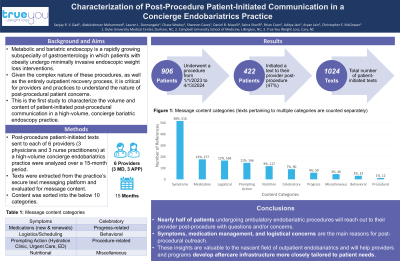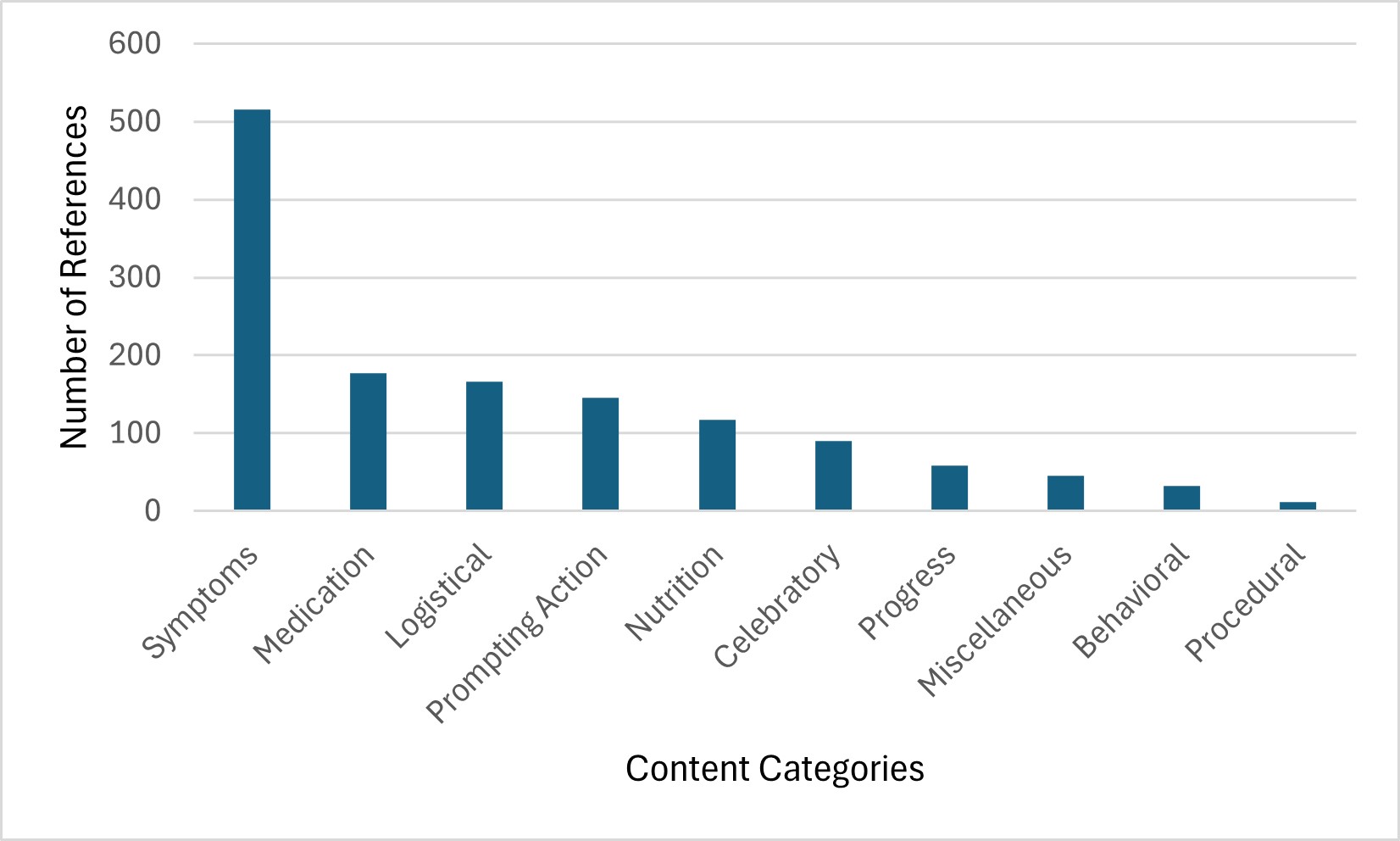Monday Poster Session
Category: Interventional Endoscopy
P2768 - Characterization of Post-Procedure Patient-Initiated Communication in a Concierge Endobariatrics Practice
Monday, October 28, 2024
10:30 AM - 4:00 PM ET
Location: Exhibit Hall E

Has Audio

Sanjay Gadi, MD
Duke University Medical Center
Durham, NC
Presenting Author(s)
Sanjay Gadi, MD1, Abdulrahman Mohammed, BS2, Lauren L. Donnangelo, MD3, Chase Wooley, BS4, Shannon Casey, MS4, Daniel Maselli, MD3, Sahra Sharifi, BS2, Brian Coan, MD4, Christopher McGowan, MD4
1Duke University Medical Center, Durham, NC; 2Campbell University School of Osteopathic Medicine, Lillington, NC; 3True You Weight Loss, Atlanta, GA; 4True You Weight Loss, Cary, NC
Introduction: Metabolic and bariatric endoscopy is a rapidly growing subspecialty of gastroenterology in which patients with obesity undergo minimally invasive endoscopic weight loss interventions. Given the complex nature of these procedures, as well as the entirely outpatient recovery process, it is critical for providers and practices to understand the nature of post-procedural patient concerns. This is the first study to characterize the volume and content of patient-initiated post-procedural communication in a high-volume, concierge bariatric endoscopy practice.
Methods: Post-procedure patient-initiated texts sent to each of 6 providers (3 physicians and 3 nurse practitioners) at a high-volume concierge endobariatrics practice were analyzed over a 15 month period. Texts were extracted from the practice’s secure text messaging platform and evaluated for message content. Content was sorted into 10 categories: symptoms, medications, logistical (such as scheduling questions), prompting action (such as dietician follow up or emergency room visit), nutritional, celebratory, progress-related, miscellaneous, behavioral (such as physical activity recommendations), and procedure-related.
Results: 906 patients underwent endoscopic sleeve gastroplasty (ESG), transoral outlet reduction (TORe), vertical sleeve gastrectomy revision (VSGR), or intragastric balloon placement/adjustment/removal between 1/1/2023 and 4/13/2024. 422 (47%) of patients texted their provider post-procedure during this period, for a total of 1,024 patient-initiated texts encompassing 1,361 content categories. Of these, 516 (38%) were symptom-related, 177 (13%) medication-related, 166 (12%) logistical, 146 (11%) prompting action, 117 (9%) nutritional, 90 (6%) celebratory, 59 (4%) progress-related, 46 (3%) miscellaneous, 32 (2%) behavioral, and 12 (1%) procedural (Figure 1). The 3 most sited symptoms were abdominal pain/cramping, followed by nausea/vomiting, and finally diminished oral intake/tolerance.
Discussion: Nearly half of patients undergoing ambulatory endobariatric procedures will reach out to his or her provider post-procedure with questions and/or concerns. The majority of these texts are related to symptoms (namely abdominal pain/cramping), medications, and logistics. These insights are valuable to the nascent field of outpatient endobariatrics and will help providers and programs develop aftercare infrastructure more closely tailored to patient needs.

Disclosures:
Sanjay Gadi, MD1, Abdulrahman Mohammed, BS2, Lauren L. Donnangelo, MD3, Chase Wooley, BS4, Shannon Casey, MS4, Daniel Maselli, MD3, Sahra Sharifi, BS2, Brian Coan, MD4, Christopher McGowan, MD4. P2768 - Characterization of Post-Procedure Patient-Initiated Communication in a Concierge Endobariatrics Practice, ACG 2024 Annual Scientific Meeting Abstracts. Philadelphia, PA: American College of Gastroenterology.
1Duke University Medical Center, Durham, NC; 2Campbell University School of Osteopathic Medicine, Lillington, NC; 3True You Weight Loss, Atlanta, GA; 4True You Weight Loss, Cary, NC
Introduction: Metabolic and bariatric endoscopy is a rapidly growing subspecialty of gastroenterology in which patients with obesity undergo minimally invasive endoscopic weight loss interventions. Given the complex nature of these procedures, as well as the entirely outpatient recovery process, it is critical for providers and practices to understand the nature of post-procedural patient concerns. This is the first study to characterize the volume and content of patient-initiated post-procedural communication in a high-volume, concierge bariatric endoscopy practice.
Methods: Post-procedure patient-initiated texts sent to each of 6 providers (3 physicians and 3 nurse practitioners) at a high-volume concierge endobariatrics practice were analyzed over a 15 month period. Texts were extracted from the practice’s secure text messaging platform and evaluated for message content. Content was sorted into 10 categories: symptoms, medications, logistical (such as scheduling questions), prompting action (such as dietician follow up or emergency room visit), nutritional, celebratory, progress-related, miscellaneous, behavioral (such as physical activity recommendations), and procedure-related.
Results: 906 patients underwent endoscopic sleeve gastroplasty (ESG), transoral outlet reduction (TORe), vertical sleeve gastrectomy revision (VSGR), or intragastric balloon placement/adjustment/removal between 1/1/2023 and 4/13/2024. 422 (47%) of patients texted their provider post-procedure during this period, for a total of 1,024 patient-initiated texts encompassing 1,361 content categories. Of these, 516 (38%) were symptom-related, 177 (13%) medication-related, 166 (12%) logistical, 146 (11%) prompting action, 117 (9%) nutritional, 90 (6%) celebratory, 59 (4%) progress-related, 46 (3%) miscellaneous, 32 (2%) behavioral, and 12 (1%) procedural (Figure 1). The 3 most sited symptoms were abdominal pain/cramping, followed by nausea/vomiting, and finally diminished oral intake/tolerance.
Discussion: Nearly half of patients undergoing ambulatory endobariatric procedures will reach out to his or her provider post-procedure with questions and/or concerns. The majority of these texts are related to symptoms (namely abdominal pain/cramping), medications, and logistics. These insights are valuable to the nascent field of outpatient endobariatrics and will help providers and programs develop aftercare infrastructure more closely tailored to patient needs.

Figure: Title: Post-Procedure Communication Content
Figure 1. Content categories of patient-initiated texts after endobariatric procedures.
Figure 1. Content categories of patient-initiated texts after endobariatric procedures.
Disclosures:
Sanjay Gadi indicated no relevant financial relationships.
Abdulrahman Mohammed indicated no relevant financial relationships.
Lauren Donnangelo indicated no relevant financial relationships.
Chase Wooley indicated no relevant financial relationships.
Shannon Casey indicated no relevant financial relationships.
Daniel Maselli: Apollo Endosurgery – Consultant. Boston Scientific – Consultant.
Sahra Sharifi indicated no relevant financial relationships.
Brian Coan indicated no relevant financial relationships.
Christopher McGowan: Boston Scientific – Consultant.
Sanjay Gadi, MD1, Abdulrahman Mohammed, BS2, Lauren L. Donnangelo, MD3, Chase Wooley, BS4, Shannon Casey, MS4, Daniel Maselli, MD3, Sahra Sharifi, BS2, Brian Coan, MD4, Christopher McGowan, MD4. P2768 - Characterization of Post-Procedure Patient-Initiated Communication in a Concierge Endobariatrics Practice, ACG 2024 Annual Scientific Meeting Abstracts. Philadelphia, PA: American College of Gastroenterology.
